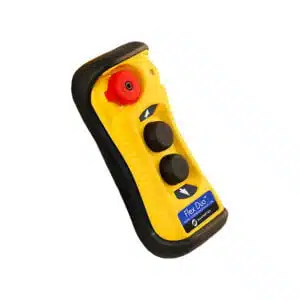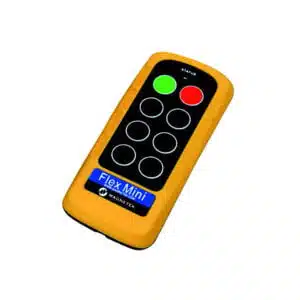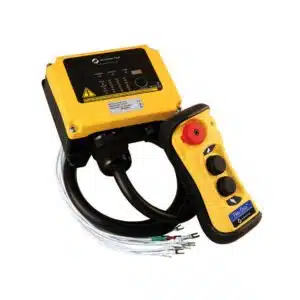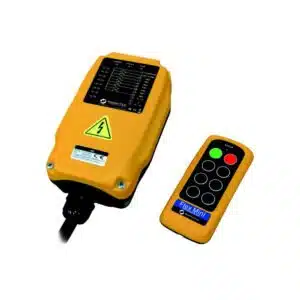Flex Duo
Flex Mini
Transmitters
Magnetek Flex Duo & Flex Mini: What’s The Difference?
The Magnetek Flex Duo is designed for complex, heavy-duty operations with dual-motion control capabilities and enhanced safety features. In contrast, the Flex Mini offers a simpler, more compact solution ideal for light-duty tasks, emphasizing portability, and cost-effectiveness.
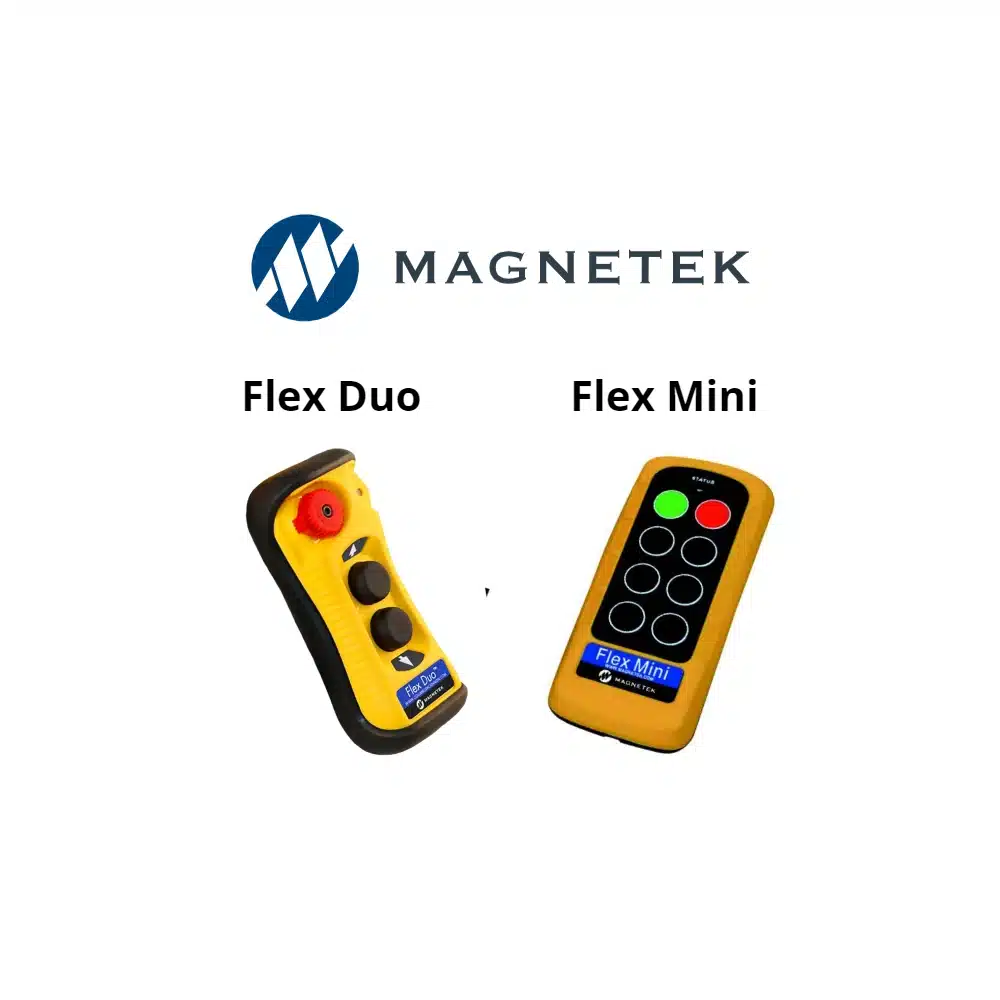
Initial Thoughts
In the realm of industrial operations, selecting the right equipment is crucial for enhancing efficiency, ensuring safety, and optimizing performance.
Among the tools at the forefront of innovation and utility are the Magnetek Flex Duo and Flex Mini remote controls. These devices, designed by Magnetek, a leader in motion control technologies, offer distinct features tailored to meet the diverse needs of modern industries.
We created this guide to dissect and compare these two models, clarifying their differences and outlining their unique advantages.
Overview of Magnetek Flex Duo
The Magnetek Flex Duo is a sophisticated tool designed for precision and ease of use in industrial settings. Here’s a breakdown of its design, features, specifications, and applications:
Design and Usability
- Handheld Device: Compact, two-button radio remote control designed for single-motion applications.
- Ergonomic Design: Lightweight and contoured to fit comfortably in the operator’s hand, minimizing fatigue during extended use.
Key Features
- Safety and Visibility: Enhances operator safety by allowing remote operation from a safe distance, reducing risk in potentially hazardous environments.
- Improved Positioning: Offers better vantage points for visibility and precision, crucial for the accurate operation of machinery.
- Durable Construction: Built to withstand harsh industrial conditions, ensuring reliability and longevity.
Technical Specifications
- Control Options: Available in various configurations to match specific industrial needs, including different control voltages and optional horn kits.
- Speed Settings: Supports two-speed operations, providing flexibility between gradual and rapid movement controls.
Applications and Options
- Versatile Use: Ideal for a range of applications beyond typical industrial environments, such as boat lifts, trailers, and pumps.
- Modular Integration: Easily integrates with other systems, enhancing its utility across different operational setups.
Overview of Magnetek Flex Mini
The Magnetek Flex Mini is designed as a streamlined and cost-effective solution for less complex control needs in industrial environments. Below is an overview of its design, key features, technical specifications, and applications:
Design and Usability
- Compact and Portable: The Flex Mini is small enough to fit inside a shirt pocket, making it extremely portable and easy to handle.
- Simple Operation: Designed for straightforward operations with fewer buttons, making it ideal for less complex tasks.
Key Features
- Ease of Use: Its simplicity allows for quick mastery by operators, reducing training time and potential operational errors.
- Lightweight Construction: Minimizes operator fatigue, suitable for long-term use without discomfort.
- Durability: Rated to withstand industrial and outdoor environments, ensuring reliability under tough conditions.
Technical Specifications
- Button Configuration: Features 8 pushbuttons typically configured for on/off operations, providing precise control.
- Protection Rating: Comes with a NEMA 4 (IP66) rating, indicating a high level of protection against dust and water.
Applications and Options
- Flexible Applications: Although primarily used in simpler industrial applications, its versatility makes it suitable for a variety of light-duty tasks.
- Customizable Labels: Offers options for standard and custom labeling, enhancing its adaptability to specific operational needs.
Magnetek Flex Duo & Flex Mini Transmitters For Sale
Comparative Analysis
When choosing between the Magnetek Flex Duo and Flex Mini, it is crucial to understand their specific strengths and optimal use scenarios. This comparative analysis will highlight key differences in functionality, design, and application suitability, helping to determine which device best fits certain industrial needs.
Functionality and Control Features
- Flex Duo: Offers dual-motion controls, allowing for more complex operations such as up/down and forward/backward movements. It is equipped with two-speed settings, enhancing its capability to handle varied operational intensities.
- Flex Mini: Primarily provides single-speed functionality with a straightforward eight-button configuration. It is best suited for simpler tasks where precision control over multiple speeds is less critical.
Physical Characteristics
- Flex Duo: Larger and more robust, designed to endure the rigors of heavy industrial use. Its construction is geared towards prolonged durability and can accommodate additional features like horn kits for enhanced functionality.
- Flex Mini: Smaller and more compact, making it highly portable and easy to store. Ideal for light-duty tasks where space and ease of handling are priorities.
Suitability for Different Types of Operations
- Flex Duo: Best for industries where precise control over heavy machinery is required, such as in large manufacturing facilities or for operating cranes and hoists in construction.
- Flex Mini: More appropriate for less demanding environments, such as small workshops or for remote control of equipment in confined spaces where simple on/off functionality suffices.
Safety and Ergonomics
- Flex Duo: Enhances safety by allowing operators to control equipment from a safer distance, potentially reducing the risk of accidents in hazardous environments.
- Flex Mini: While also safe, it focuses more on operator comfort and preventing fatigue, given its lightweight design and ease of use.
Cost-Effectiveness
- Flex Duo: Due to its specialized features and robust design, it tends to be more expensive, suitable for businesses that require a high degree of control and durability.
- Flex Mini: Offers a more budget-friendly option for businesses that need basic control functions without the additional complexities and costs associated with more advanced systems.
Case Studies
Let’s explore practical applications of the Magnetek Flex Duo and Flex Mini through hypothetical case studies. These examples illustrate how different industries utilize these remote controls to enhance operational efficiency, safety, and user experience.
Case Study 1: Flex Duo in a Manufacturing Facility
- Scenario: A large automotive manufacturing facility implements the Flex Duo to manage assembly line cranes. The facility requires precise control to move heavy car parts across the assembly line.
- Outcome: The dual-motion and two-speed capabilities of the Flex Duo allow operators to maneuver large components smoothly and accurately, reducing cycle times and minimizing the risk of accidents. The enhanced safety features and robust design provide reliability in the demanding industrial environment, leading to improved overall efficiency.
Case Study 2: Flex Mini in Event Production
- Scenario: A production company uses the Flex Mini to control lighting and sound equipment during live events. The simplicity and portability of the Flex Mini make it ideal for quick setups and adjustments in various locations.
- Outcome: Operators find the Flex Mini easy to use, significantly reducing setup times and allowing for rapid changes during events. The compact size and lightweight design help prevent fatigue during long performances, while its durability withstands the rigors of frequent transport and outdoor use.
Case Study 3: Flex Duo in Construction
- Scenario: A construction company uses the Flex Duo for a crane operation in a high-rise building project. The project requires precise lifting of materials to great heights with enhanced visibility and safety.
- Outcome: The Flex Duo’s capability for long-range operation and its safety features, such as emergency stops and better positioning, increase operator confidence and control accuracy. This leads to faster completion times and a safer working environment, showcasing the Flex Duo’s impact on complex construction tasks.
Case Study 4: Flex Mini in Small Warehouses
- Scenario: A small warehouse adopts the Flex Mini to operate overhead hoists for stacking and retrieving inventory. The warehouse seeks a simple, effective solution that staff can quickly learn to use.
- Outcome: The Flex Mini’s straightforward design proves ideal for the warehouse’s needs, enabling staff to operate the hoists efficiently with minimal training. The cost-effectiveness of the Flex Mini also makes it a practical choice for the warehouse, optimizing operations without a significant investment.
Choosing The Right Transmitter
Selecting the right transmitter between the Magnetek Flex Duo and Flex Mini depends heavily on the specific needs and conditions of your operation. Each transmitter excels in different scenarios, making it crucial to consider the context in which it will be used. Below, we provide guidance on which transmitter is better suited for various operational environments.
Heavy-Duty Operations
- Recommended Transmitter: Flex Duo
- Why: The Flex Duo is designed for more complex and demanding environments where precise control and robust functionality are required. Its dual-motion control allows for handling operations that involve multiple directions, such as up/down and forward/backward movements, which are typical in heavy industrial settings like manufacturing plants or construction sites. The added safety features and enhanced visibility options make it the preferred choice for tasks that involve large machinery or potentially hazardous conditions.
Light-Duty and Simple Operations
- Recommended Transmitter: Flex Mini
- Why: For operations that require basic functionality without the complexity of multiple speeds or directions, the Flex Mini is ideal. Its compact size and ease of use make it perfect for environments like small workshops, event productions, or light warehouse tasks. The Flex Mini offers the essential features needed for straightforward tasks, ensuring operational efficiency without the overhead of more advanced controls.
Cost-Effective Solutions
- Recommended Transmitter: Flex Mini
- Why: When budget constraints are a concern, and the operational demands do not justify a high-end solution, the Flex Mini serves as the more economical choice. It provides reliable control for basic operations, making it a cost-effective option for businesses looking to optimize their expenditures without sacrificing quality and safety.
Enhanced Operator Mobility and Safety
- Recommended Transmitter: Flex Duo
- Why: In scenarios where operator mobility is critical, and there is a need to maintain safety while managing equipment from a distance, the Flex Duo proves superior. Its design supports better positioning and movement freedom, which are crucial in maintaining a safe distance from dangerous equipment while still ensuring effective operation.
Ease of Use and Training
- Recommended Transmitter: Flex Mini
- Why: The Flex Mini’s simplicity is advantageous in situations where quick training and ease of use are prioritized. This transmitter is particularly beneficial in settings where multiple staff members may need to operate the device with minimal training, such as in retail environments or during event setups.
Final Thoughts
Choosing the right remote control system from Magnetek, whether the Flex Duo or the Flex Mini, can significantly enhance operational efficiency, safety, and user satisfaction in various industrial environments. Each model has been designed with specific user scenarios in mind, making it imperative to understand their unique features and capabilities before making a decision.
The Flex Duo is ideal for complex and demanding industrial applications where robust functionality and enhanced safety measures are required. Its ability to handle dual-motion tasks with precision makes it a valuable asset in heavy-duty environments such as manufacturing plants and construction sites.
On the other hand, the Flex Mini is more suited for lighter and less complex tasks where simplicity, cost-effectiveness, and ease of use are key considerations. Its compact and straightforward design makes it perfect for small workshops, event productions, or light warehousing needs.

